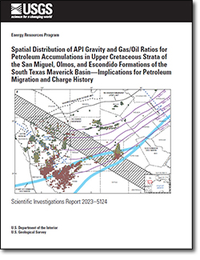Spatial Distribution of API Gravity and Gas/Oil Ratios for Petroleum Accumulations in Upper Cretaceous Strata of the San Miguel, Olmos, and Escondido Formations of the South Texas Maverick Basin—Implications for Petroleum Migration and Charge History
Links
- Document: Report (2.88 MB pdf) , HTML , XML
- Download citation as: RIS | Dublin Core
Abstract
The Maverick Basin of south Texas is currently undergoing active exploration and production of gas and oil from tight sandstone reservoirs. The most productive tight sandstones in the basin are in the Upper Cretaceous San Miguel, Olmos, and Escondido Formations. These units are second only to the Eagle Ford Shale in terms of cumulative production volumes. The structural history of the Maverick Basin, from rifting to subsidence to exhumation, has had a profound effect on the characteristics of these reservoirs and the petroleum resources contained therein. This U.S. Geological Survey review of the production history of these strata reflects a recent shift from conventional production to horizontal drilling (unconventional) that exploits low permeability reservoirs in previously overlooked areas of existing oil and gas fields in southern Texas, typically outside of established field boundaries.
To investigate the physical properties of the Maverick Basin hydrocarbon accumulations, this case study compiled American Petroleum Institute (API) gravity measurements and calculated cumulative gas/oil ratios (GOR) for thousands of producing wells from the San Miguel, Olmos, and Escondido Formations. Maps were generated from the compiled well production data to show the spatial heterogeneity of API gravity and GOR values for the three formations within the Maverick Basin and immediately outside the basin to the northeast. Within the Maverick Basin, the spatial patterns of API gravity values indicate lighter oils downdip towards the southern basin edge. GOR values indicative of wet and dry gases within the basin are seen interspersed, with values that correspond to black and heavy oils. Differences in the spatial patterns of the petroleum properties within the Maverick Basin are interpreted as effects of Eocene basin inversion caused by Laramide orogenic deformation, and the resulting reservoir exhumation of basin strata. East of the Maverick Basin, spatial distributions of API gravity and GOR values show progressively heavier oils updip to the northwest, grading to dry gases downdip to the southeast, which correlates to the oil and gas windows of the underlying Eagle Ford Shale.
Correlation of API gravity and GOR values from the San Miguel, Olmos, and Escondido Formations with thermal maturity data from the Eagle Ford Shale suggests that the Eagle Ford Shale is the petroleum source, and that petroleum migration was approximately vertical for areas to the east of the Maverick Basin. The discontinuity of API gravity and GOR properties within the Maverick Basin implies a complex petroleum charge history, possibly involving the remigration of petroleum and the addition of petroleum from other source intervals in Mexico, to the southwest. Depressurization of exhumed, overpressured reservoirs of the San Miguel, Olmos, and Escondido Formations can explain the intermittent occurrence of gas production throughout the southern Maverick Basin by exsolution of gas from formation brines and the resulting dry gas flushing of hydrocarbon-charged reservoirs. The introduction of dry gas through flushing can, in turn, explain why the patterns of API gravity and GOR values are so dissimilar in the Maverick Basin. This process has implications for possible future production of unconventional resources from undiscovered tight-gas reservoirs in strata of the San Miguel, Olmos, and Escondido Formations, and a different approach to petroleum exploration may be needed in the Maverick Basin relative to exploration techniques applied in other basins within the northern Gulf of Mexico.
Suggested Citation
Doolan, C.A., Craddock, W.H., Buursink, M.L., Hatcherian, J.J., and Cahan, S.M., 2024, Spatial distribution of API gravity and gas/oil ratios for petroleum accumulations in Upper Cretaceous strata of the San Miguel, Olmos, and Escondido Formations of the south Texas Maverick Basin—Implications for petroleum migration and charge history: U.S. Geological Survey Scientific Investigations Report 2023–5124, 24 p., https://doi.org/10.3133/sir20235124.
ISSN: 2328-0328 (online)
Study Area
Table of Contents
- Abstract
- Introduction
- Geologic Setting
- Methods for API Gravity and Gas/Oil Ratio (GOR) Mapping
- Resulting Spatial Patterns of Petroleum Properties
- Discussion
- Summary
- Acknowledgments
- References Cited
| Publication type | Report |
|---|---|
| Publication Subtype | USGS Numbered Series |
| Title | Spatial distribution of API gravity and gas/oil ratios for petroleum accumulations in Upper Cretaceous strata of the San Miguel, Olmos, and Escondido Formations of the south Texas Maverick Basin—Implications for petroleum migration and charge history |
| Series title | Scientific Investigations Report |
| Series number | 2023-5124 |
| DOI | 10.3133/sir20235124 |
| Publication Date | March 26, 2024 |
| Year Published | 2024 |
| Language | English |
| Publisher | U.S. Geological Survey |
| Publisher location | Reston, VA |
| Contributing office(s) | Eastern Energy Resources Science Center, Geology, Energy & Minerals Science Center |
| Description | iv, 24 p. |
| Country | United States |
| State | Texas |
| Other Geospatial | Maverick Basin |
| Online Only (Y/N) | Y |
| Additional Online Files (Y/N) | N |


